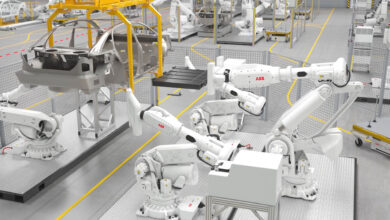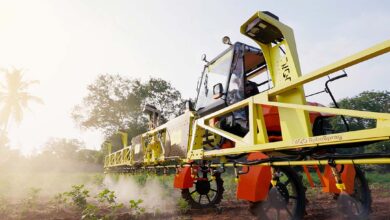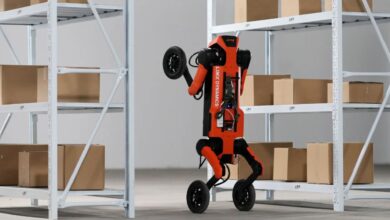Robotic welding system boosts Smoker Craft’s production – Indianapolis Business Journal
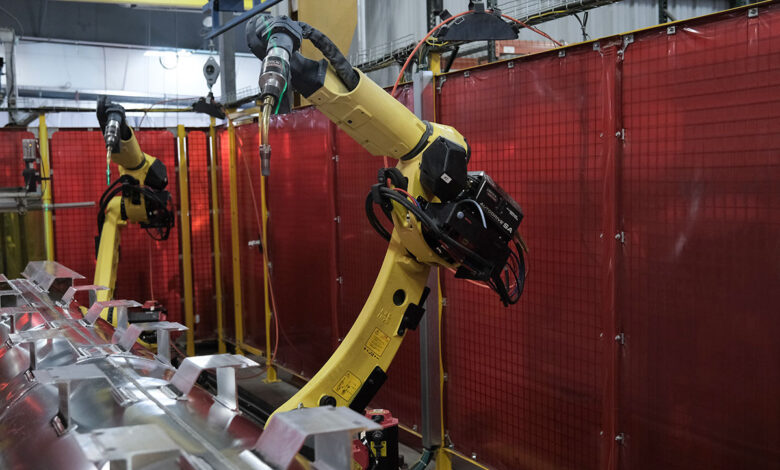
A welder’s flame fuses a pontoon tube at Smoker Craft Inc.’s manufacturing campus in Elkhart County, but no one is holding the torch. Rather, three computer-controlled robots are doing the work.
It’s a major change from the way pontoon boats used to be made at the family-owned company that has been in operation for more than a century in New Paris, three hours north of Indianapolis.
Smoker Craft, which specializes in the production of aluminum boats, adopted a robotic tube-welding system about two years ago to automate its entire pontoon assembly process. The company has received attention for its system and last month earned the Conexus Indiana Manufacturing Innovation Award at TechPoint’s 2024 Mira Awards gala.
Smoker Craft began exploring the idea of installing a robotic tube-welding system in 2021 when the company didn’t have enough employees to meet the demand for pontoon boats during the pandemic.
“Welders were hard to find up here,” Smoker Craft President Doug Smoker said. “And this helped us in a big way.”
Michael Boyle, process and innovation engineer at Smoker Craft, said the company’s leaders asked themselves, “How can we add to what we are currently doing?”
“That was really big,” Boyle said. “We wanted to increase our production, and the truth is just that the skilled labor that we needed to do that doesn’t exist … so that was kind of what pushed us towards automation.”
So, how does Smoker Craft’s robotic welding system work?
First, a machine roller turns flat sheets of aluminum into round cylinders. Then, the cylinders move to the welding stations where they lie on a track.
Three computer-controlled robot arms use welders to seal each cylinder closed with a weld along the length of the tube. Rollers on the track then rotate the tube to let the robots weld around its diameter.
Nose cones and end caps, formed nearby, are then welded onto each end to complete the pontoon tube. A human worker who oversees the station and operates a computer screen pushes a track that positions multiple aluminum brackets into place before the robots weld them to the tube.
The welding process, which used to take more than an hour when done manually, is now condensed into 10-1/2 minutes. The automated side also requires a much smaller footprint than Smoker Craft’s manual production side.
“The fact that they’re able to develop this system, upskill the existing workforce and start to get their employees engaged with the robotics and the programs, it’s pretty impressive,” said Ryan Henderson, director of innovation and technical transformation for Conexus Indiana.
Smoker Craft received a $200,000 Manufacturing Readiness Grant two years ago from Conexus Indiana to get started. Then the company worked with South Bend-based enFocus Inc., a not-for-profit that helps Indiana manufacturers develop high-impact projects.
EnFocus connected Smoker Craft with Fort Wayne-based Guide Engineering, which worked with the boat manufacturer for about a year to develop a $6 million automation system to weld aluminum pontoons and their components.
The robotic system did not replace employees; the humans received training to use the machines. Smoker Craft employs about 500 people, who mostly live in Elkhart, Kosciusko and LaGrange counties.
“Along that path, we had to change how we build boats,” Boyle said. “We touched essentially every single component that is happening in the automated cells in order to create consistency.”
Ellen Bradley, senior vice president of the National Marine Manufacturers Association, said innovation in the boating industry has been accelerated since the pandemic began increasing demand in 2020.
“That is one piece that’s driving the innovation,” she said. “And then certainly just some of the efficiencies that come along with a lot of the innovation and in different technologies that allows the manufacturers to implement, whether that’s automation and machine learning or AI or other types of approaches that help improve efficiency.”
Smoker Craft Inc. manufactures five boat brands: Smoker Craft, Starcraft, Starweld, SunChaser and Sylvan.
Starcraft, SunChaser and Sylvan are the company’s pontoon boat brands. They represent about 350 models and about 75% of Smoker Craft Inc.’s annual sales. The Smoker Craft brand is the company’s aluminum fishing boat, while Starweld is a line of fiberglass V-hull boats.
Boyle said the robotic tube-welding system creates a wide variety of pontoon boats, ranging from a simple $30,000 version to a high-end $200,000 model.
“It takes a flexible company who’s willing to make changes and adopt their product to fit kind of a new way of manufacturing, which ultimately leads to better boats,” Boyle said. “Sometimes, the boating industry is kind of rooted in tradition, and sometimes it’s hard to break.”
Smoker Craft Inc. is a huge operation in a community of about 1,600 people. Its sprawling campus has 37 buildings with about 1 million square feet of manufacturing and storage space.
The company’s roots are connected to two families—the Schrocks and the Smokers—who have a long history of collaboration in northern Indiana’s boat manufacturing industry.
“It’s still maintained as a family business,” Smoker said. “We treat it as such and treat our employees that way.”
Smoker Craft Vice President Peter Barrett is the great-grandson of Arthur Schrock, who in 1903 went to work for the Star Tank Co. in the Elkhart County town of Middlebury. Schrock purchased the company in 1926 and changed its name to Starcraft, which by then focused on manufacturing boats.
And Smoker is the great-grandson of John Smoker, who founded Smoker Lumber Co. in 1921 in New Paris. The lumber company became Smoker Oar and Paddle Co., which provided materials to Starcraft and became the country’s largest manufacturer of oars and paddles. It began producing boats as Smoker Craft in 1963.
Smoker said the families began working together as one company in 1996.
“It’s unusual for a family business to be together for five generations,” he said. “The families have gotten along well together, and we’re ready for our next challenge. And when we came into looking at what we needed to do, we felt we needed to bring automation into play.”
Northern Indiana—and Elkhart County in particular—is known as the recreational vehicle manufacturing hub of the United States.
But boat-making is also big in the region, with its numerous lakes and its proximity to Lake Michigan. Smoker Craft Inc. is one of several pontoon boat manufacturers in the area.
Barletta Pontoons, Bennington Marine LLC and Godfrey Pontoon Boats also operate in Elkhart County. Cypress Cay Pontoons and Harris Boats operate in Fort Wayne in Allen County, while JC Manufacturing is in North Webster in Kosciusko County.
According to statistics kept by the National Marine Manufacturers Association, the recreational boating industry had a $5.7 billion economic impact in 2022 in Indiana. The industry supported 425 businesses and 17,200 jobs. There were 202,750 registered boats in the state, and people spent $462.4 million on boats, engines, trailers and accessories.
“Indiana is the pontoon boat capital of the world,” Bradley said.
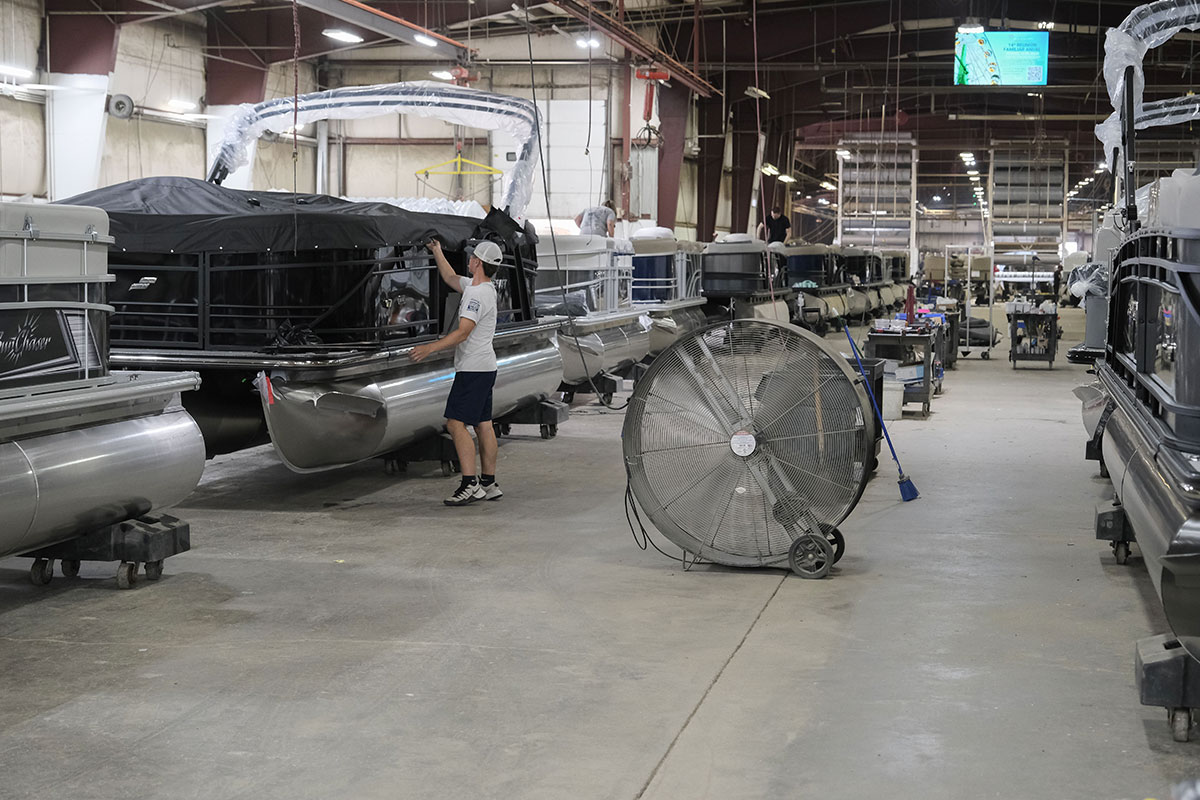
Growing technology
Mitch Landess, vice president of innovation and digital transformation for Conexus Indiana, said manual systems result in welders spending 80% of their time moving materials around, rather than welding.
That means, he added, that there is no reason manufacturers should have humans focusing on tasks that technology and machines can do better.
Robotics, cloud computing and industrial Internet of Things are three technologies every manufacturing company should use to stay competitive, according to Landess.
“We’re not displacing the workforce so much as we’re freeing them up from the manual tasks so that they can maybe tend to the system and be more creative and thoughtful about their work,” he said. “We’re going to see that technology adoption is very important for productivity reasons with these companies.”
Boyle said the new welding system made the most sense for Smoker Craft, even if it took employees a little time to adjust.
“They slowly began to really believe, and then once the product that we were producing was of a higher quality, they really started to take pride in it,” he said. “It went from not necessarily being an adversary of the project, but there was certainly a little bit of restraint. [And now] the guys are extremely proud of what they’re able to do.”
Boyle recently attended Automate, the largest robotics and automation trade show in North America, when the convention was held in Chicago early this month. He said boat manufacturers reported an increase in usage of artificial intelligence and machine learning in production.
“The quality of the product and the proficiency and productivity [are] too good to ignore, especially as technology continues to advance,” he said. “As that technology continues to advance, I think we’re going to see a lot more adoption of this new automation.”•




